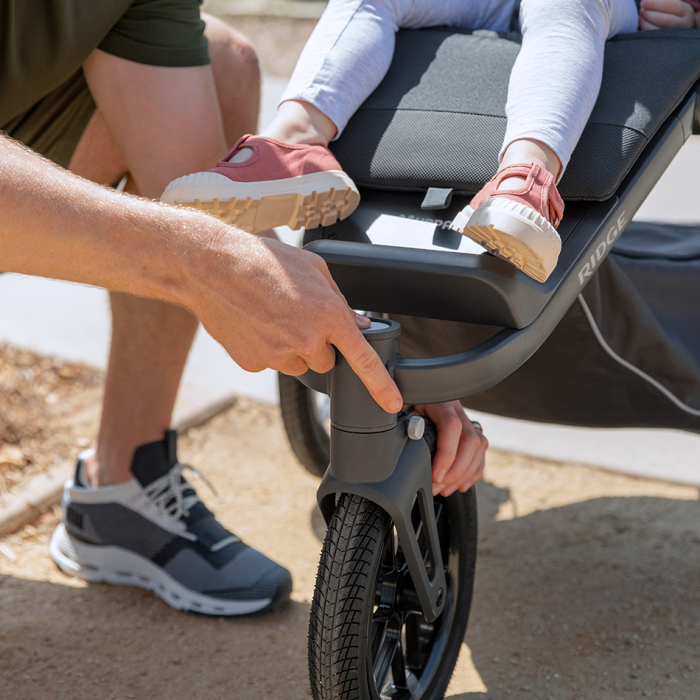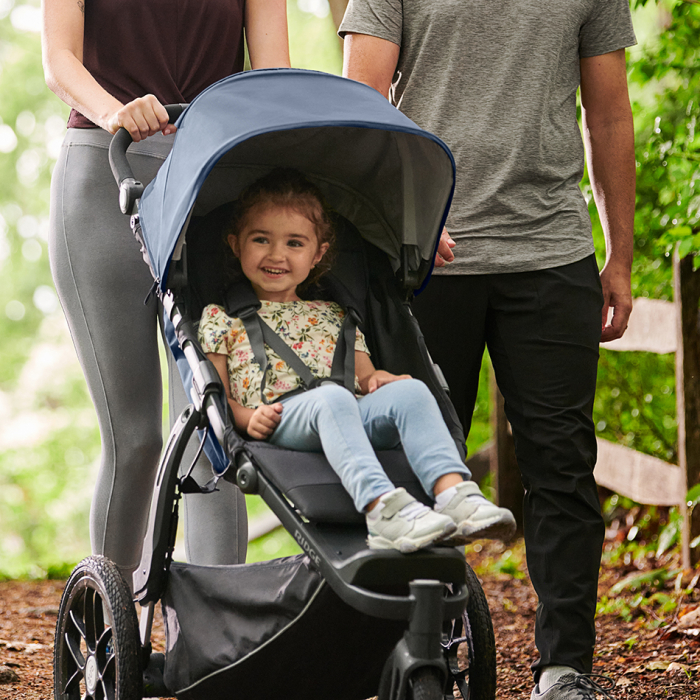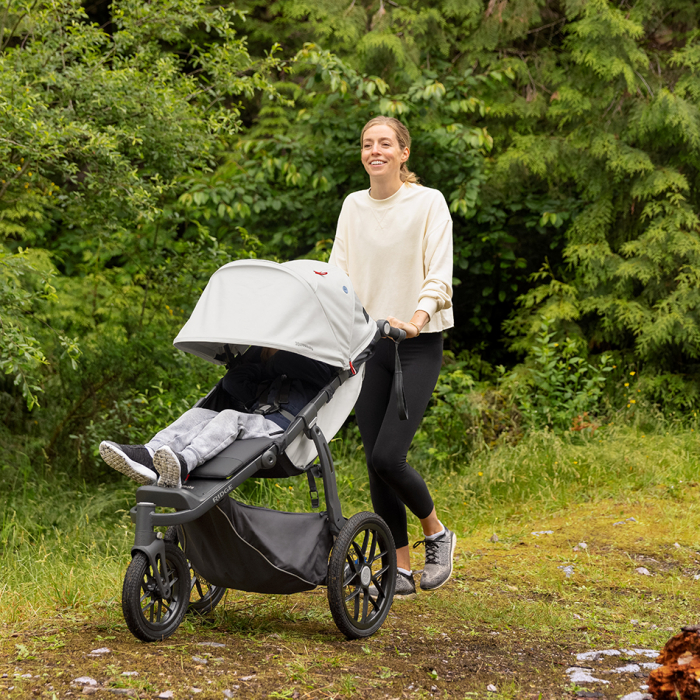

Cover more ground.™
De robuuste Ridge past zich aan aan elke ondergrond en elk wandeltempo. Dankzij zijn slimme, aanpasbare functies biedt hij comfort voor zowel de ouder/verzorger als voor het kindje, of je nu over kinderkopjes loopt of in het bos. Met de verfijnde maar toch robuuste Ridge houdt niets je tegen om op ontdekkingstocht te gaan.
Gemaakt om te presteren

De geavanceerde, soepele vering is geschikt voor elk terrein
Het efficiënte veringsssysteem met soepel reagerende spiraalveren zorgt ervoor dat je kindje altijd comfortabel zit bij rijden over elke ondergrond.
Nooit een lekke band
In de banden zit geen lucht, dus je hoeft geen pompje mee te nemen. Grote wielen van 30,5 en 40,6 cm met een diep profiel zorgen voor een soepele rit over elke ondergrond.
Handremsysteem met schijfrem
Betrouwbare handrem om je snelheid te verminderen, zelfs bergafwaarts.
Makkelijk remmen, lekker wandelen
Rood pedaal om te remmen. Groen pedaal om te ontgrendelen. Net zo makkelijk te gebruiken als te herkennen.


Vergrendelbaar zwenkwiel aan voorkant
Als het nodig is vanwege de ondergrond, kun je het voorwiel met één druk op de knop vergrendelen. Een indicator laat zien in welke stand het wiel staat, en de verstelbare tracker helpt je het wiel nauwkeurig uit te lijnen zodat je recht en soepel kunt wandelen.
Ontworpen voor comfort
Jij duwt. Je kindje kan ontspannen.
Een diep, gewatteerd zitje houdt je kind veilig en comfortabel genesteld. De verstelbare rugleuning zorgt ervoor dat kleine passagiers snel kunnen omschakelen van sightseeing naar een dutje doen.

Duwbeugel met vier standen
Geschikt voor vier verschillende ellebooghoogten voor afgestemd duwcomfort.

Ontdek op je gemak

Gemaakt voor schaduw
De zonnekap kan eenvoudig worden opengeritst en verlengd zodat je kindje beschermd wordt tegen de zon en tegen afleiding uit de omgeving tijdens een dutje. Door het kijkvenster kun je even spieken hoe het met je kindje gaat of je kunt de flap open laten voor meer ventilatie.
Vouw met één hand op
Je vouwt de hele wandelwagen snel en eenvoudig op met een duw- en draaibeweging van één hand. Na het inklappen blijft de wagen rechtop staan.



Extra gratis stalen van stoffen
Weet je niet zeker welke stof bij je past? Gebruik ons Select Your Style-programma en kies maximaal 4 gratis stofstalen voor kinderwagens, die rechtstreeks bij je worden bezorgd.
Opties vanaf de geboorte en uitbreiding

Meer vanaf dag 1
Met de reiswieg vorm je jouw Ridge om tot een kinderwagen met behulp van de juiste adapters.


Compatibel met Mesa i-Size en meer
Bevestig de handige adapters en haal je baby uit de auto voor een wandeling in het Mesa i-Size autozitje of bepaalde autostoeltjes van Maxi-Cosi®, Cybex en BeSafe®.
PiggyBack accessoire
Met de Ridge kun je eenvoudig een tweede kind vervoeren wanneer je het PiggyBack meerijdplankje aan het frame bevestigt. Perfect voor jonge wandelaars die af en toe willen uitrusten.

Specificaties
Geschikt vanaf 6 maanden tot 22 kg
Geschikt vanaf de geboorte met goedgekeurde accessoires
Werkelijk gewicht (inclusief kap, wielen en boodschappenmand): 13,2 kg
Uitgevouwen: 97,8 L x 66 B x 102,9 H cm
Opgevouwen: 47 L x 66 B x 92,7 H cm
Wat zit er bij
- Fleshouder
- Basket Cover
- Anti-lek banden van 30,5 en 40,6 cm
Belangrijkste functies
- Verlengbare zonnekap met kijkvenster van gaas en opbergvakje met rits
- Handremsysteem met schijfrem
- Verstelbare duwbeugel met polsband
- Met fleshouder
- Diep, comfortabel zitje met singelband om rugleuning te verstellen
- Reflecterende accenten
- Grote boodschappenmand met afdekhoes
- Vergrendelbaar zwenkwiel aan voorkant en verstelbare tracker
- Anti-lek banden van 30,5 en 40,6 cm
- Opvouwen met één hand, blijft opgevouwen zelfstandig rechtop staan
- Vanaf de geboorte compatibel met de reismand, Mesa i-Size en andere autozitjes met gebruik van adapters
- Vijfpuntsgordel met lendensteun
- vering met een gepatenteerd tweetrapssysteem



